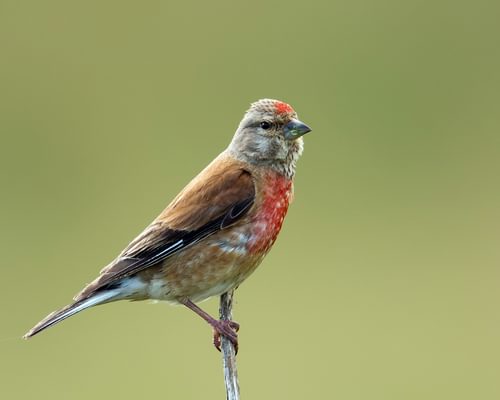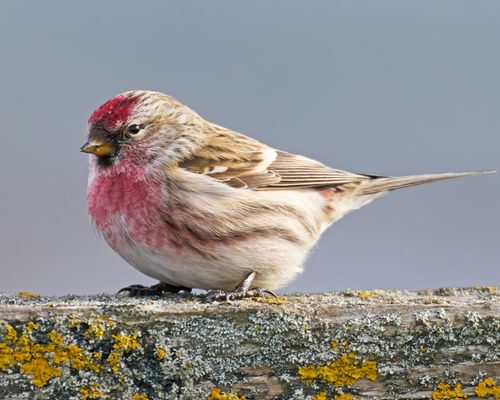Twite
Least ConcernLinaria flavirostris
Visual Identification
Appearance
The Twite is a small, slender finch with a streaked brown body and buff-edged wing feathers. Its most distinctive features are a yellow bill and a forked tail. Males display a pink rump, especially prominent during the breeding season. Their bills turn grey during the summer.
Females closely resemble males but lack the pink rump, and the white markings on the wing are less defined. Juveniles have a darker, more heavily streaked appearance and a greyish bill that gradually turns yellow as they mature.
Size
Length
13cm to 14cm
Wingspan
21cm to 23cm
Weight
15g to 20g
Habitat and Distribution
Habitats
Woodland
Garden
Wetland
Coastal
Urban
Farmland
Grassland
Desert
Tundra
Rainforest
Mountain
Savanna
Distribution
Twites inhabit open, treeless areas, including coastal cliffs, upland moors, and mountain slopes. They are found across northern Europe and Asia, with significant populations in Scotland and northern England.
In winter, many birds move to lowland coastal areas. In the UK, they are year-round residents in Scotland but only winter visitors in southern England.
Elevation Range
Sea level to 2,000 meters
Climate zones
Temperate, Subarctic
Distribution Map
This map gives you a rough idea of where you might spot a Twite. The coloured areas show countries where these birds have been seen.
A few things to keep in mind:
- Birds might not be everywhere in the coloured areas, for example, they may be present around the coast of that country
- Where birds live can change with seasons and available food
- This map is quite simple - it doesn't show exact locations
We're working on making our maps even better! Soon, we hope to show you:
- More detailed maps for bigger countries, including state and region
- How birds move around during different seasons
Distribution by Region
Behaviour and Ecology
Bird Attributes
This feature is in beta. We'd love your feedback to improve it!
Share your thoughtsBird Attributes Explained
Our bird attributes system rates various aspects of a bird's capabilities on a scale of 0-100, based on data from field observations, scientific studies, and expert knowledge.
Attribute Categories:
- Agility: Manoeuvrability, speed, and grace in flight or movement.
- Strength: Physical power, often correlating with size and hunting abilities.
- Adaptability: Ability to thrive in various environments or changing conditions.
- Aggressiveness: Territorial behaviour and assertiveness, particularly during breeding seasons.
- Endurance: Stamina, often seen in migration patterns or foraging behaviours.
Understanding the Ratings:
- 0-20: Very Low
- 21-40: Low
- 41-60: Average
- 61-80: High
- 81-100: Very High
Remember, these attributes are relative to other bird species and don't necessarily indicate superiority.
Hover over the icon next to each attribute for more information.
Tap the icon next to each attribute for more information.
Agility
Reflects the bird's manoeuvrability, speed, and grace in flight or movement.
The Twite demonstrates considerable agility with its bouncy flight pattern and quick movements while foraging on the ground. Its ability to navigate coastal cliffs and upland moors suggests good manoeuvrability.
Strength
Indicates the bird's physical power, often correlating with size and hunting abilities.
As a small finch weighing only 15-20 grams, the Twite has limited physical strength. However, it possesses enough power to perform aerial displays and build nests in challenging environments.
Adaptability
Represents the bird's ability to thrive in various environments or changing conditions.
Twites show good adaptability by inhabiting diverse environments from sea level to 2,000 metres elevation. Their ability to shift between breeding and wintering grounds, and to form mixed flocks with other species, indicates flexibility in behaviour and habitat use.
Aggressiveness
Measures the bird's territorial behaviour and assertiveness, particularly during breeding seasons.
Twites are generally non-aggressive, preferring to flock with their own kind and even other species. Their gregarious nature suggests a relatively peaceful disposition, though they may display some territorial behaviour during breeding season.
Endurance
Reflects the bird's stamina, often seen in migration patterns or foraging behaviours.
The Twite's partial migratory behaviour and ability to survive in harsh upland and coastal environments indicate good endurance. Their capacity to forage extensively for small seeds and perform aerial displays also suggests decent stamina for their size.
Diet
Twites primarily feed on small seeds from various plants, including meadow grasses, dandelions, and sorrels. In coastal areas, they often forage for seeds of saltmarsh plants. Some invertebrates may also be eaten, including larvae, flies and beetles.
During the breeding season, they supplement their diet with insects to feed their young.
Behaviour
Twites are gregarious birds, often seen in small flocks outside the breeding season. They have a characteristic bouncy flight pattern and frequently perch on fence posts or rocky outcrops.
During foraging, they move quickly on the ground, picking seeds with their specialised bills.
Vocalisation
The Twite's call is a distinctive, nasal 'twite' or 'twy-eet', from which it gets its name. Their song is a rapid, twittering series of notes, often delivered in flight.
During the breeding season, males sing more frequently, especially when performing courtship displays.
Nesting & Breeding
Twites form monogamous pairs during the breeding season, which typically starts in May. Males perform aerial displays and sing to attract mates.
Nests are built low in heather or gorse bushes, constructed mainly by the female using grasses, moss, and roots. The female lays 4-6 pale blue to dark blue eggs with reddish-brown spots.
Incubation lasts about 13 days, solely done by the female. Both parents feed the chicks, which fledge after 11-13 days but remain dependent on adults for several more weeks.
Lifespan
The Twite typically lives for 3 to 5 years, with a maximum recorded lifespan of 6.1 years.
Like all birds, lifespan can be affected by factors including predation, habitat quality, disease, and access to food sources.
Conservation and Status
Global Conservation Status
While globally listed as Least Concern, Twite populations have declined significantly in parts of their range, particularly in the UK.
Conservation efforts focus on maintaining suitable breeding habitats and providing winter feeding areas. Sustainable farming practices play a crucial role in their conservation.
Birdwatching Tips
- Look for Twites in coastal areas and upland regions of the UK
- Listen for their distinctive nasal 'twite' call
- Observe their bouncy flight pattern and tendency to flock
- Check for yellow bills and, in males, pink rumps during breeding season
Additional Information
Quick Facts
Other names:
Mountain Linnet
Family:
FringillidaePredators
Did You Know?
- Twites are one of the few finch species that do not feed on tree seeds.
- Their scientific name 'flavirostris' means 'yellow-billed' in Latin.
- Twites can form mixed flocks with Linnets and Redpolls in winter.
- Twite numbers have dropped dramatically in northern England since 1990, with only a handful of pairs remaining.
Was this bird profile helpful?
Your feedback helps us improve our content
Thanks for your feedback!
Your input helps us improve our content.
Community Experience
Community Ratings
No ratings yet - be the first to rate this bird!
Latest Community Reviews
No reviews yet
Sign in to be the first to review
Community Reviews
Create Your Free Account Welcome Back!
Join our community to rate birds and share your experiences. Creating an account is completely free and only takes a minute. Sign in to your account to rate birds and share your experiences with our community.
Your information is secure and will never be shared.
By creating an account, you agree to our Privacy Policy.
FAQs
How to attract Twites?
Efforts are underway to revive the struggling twite populations in the UK, with farmers offered advice on how to make their land twite-friendly to encourage breeding by the Twite Recovery Project.
Twites will be attracted by open meadows and grasslands, which offer foraging opportunities for a variety of seeds on which they can feed their young.
Moorland sites are used for nesting, and taller vegetation around the edges of heaths, with bracken and plenty of weeds, such as sorrel and dandelion, will also be beneficial to breeding twites.
By agreeing to cut hay later in the year, farmers can encourage breeding twites to nest on their land.
Similar Birds
References
- 2 3 4
website: BirdLife International. 2017. Linaria flavirostris (amended version of 2016 assessment). The IUCN Red List of Threatened Species 2017: e.T22720438A111128447.
View source - 1
journalArticle, 2006: Moller, Sociality, age at first reproduction and senescence: comparative analyses of birds, J Evol Biol, 19:682-689
View source

